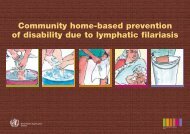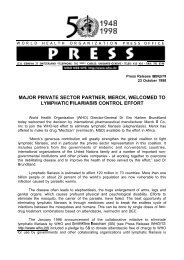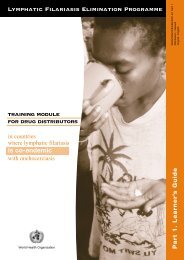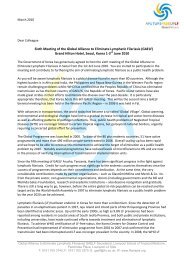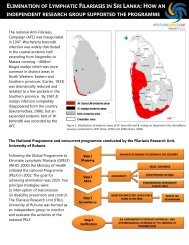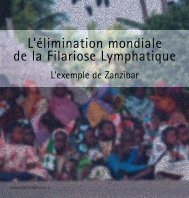Global Programme to Eliminate Lymphatic Filariasis ... - libdoc.who.int
Global Programme to Eliminate Lymphatic Filariasis ... - libdoc.who.int
Global Programme to Eliminate Lymphatic Filariasis ... - libdoc.who.int
Create successful ePaper yourself
Turn your PDF publications into a flip-book with our unique Google optimized e-Paper software.
C H A P T E R 1PROGRESS OF THE GLOBAL PROGRAMME TO ELIMINATE LYMPHATIC FILARIASISMAPPING THE DISTRIBUTION OFLYMPHATIC FILARIASISBefore the establishment of GPELF in 1999, very fewcountries had undertaken mapping of LF on a nationalscale. Endemicity was therefore either underestimatedor overestimated and its true level was unknown.In some countries, endemicity was estimated using his<strong>to</strong>ricaldata obtained from microfilaraemia prevalencesurveys carried out during treatment of infected people.This type of blood survey, however, has low sensitivityand the data obtained may therefore be inaccurate.The <strong>int</strong>roduction of the immuno-chroma<strong>to</strong>graphic test(ICT) as a rapid and practical diagnostic <strong>to</strong>ol for Wuchereriabancrofti infection has greatly improved diagnosis atfield level. The ICT is carried out on blood obtained froma finger-prick taken at any time of the day and givesresults within a few minutes, unlike the microfilaraemiaparasi<strong>to</strong>logical test which has <strong>to</strong> be performed atnight, between 22:00 and 02:00. The ICT is easy <strong>to</strong> doand its greater sensitivity results in more reliable dataon the distribution of LF endemicity.GPELF has also supported training of programme managersin all the <strong>Programme</strong> Review Group (PRG) regionsin the use of a software package developed by the WorldHealth Organization called HealthMapper. This is an<strong>int</strong>egrated database management and mapping <strong>to</strong>ol thatenables national LF programme managers <strong>to</strong> analyse geographicaldistribution of LF. It can also aid the process ofanalysing LF distribution with that of other diseases. Theanalysis of endemic areas bordering on other endemiccountries is beneficial <strong>to</strong> operations in cross-border situationswhere migration is high. In addition, the Africanand PacCARE PRGs have developed database software <strong>to</strong>handle their data.From as early as 1998, many countries in the Pacificregion began mapping using the methodology recommendedby GPELF. In most cases, this mapping exerciseconfirmed the validity of data on LF endemicity in countriespreviously gathered by microfilaraemia.Since 2000, with GPELF support, other regional PRGseither completed or began LF mapping. In 2002, someoperational problems were encountered with the use ofICT cards because of a change in the manufacturing process.The new ICT card that was subsequently developed<strong>to</strong> overcome those problems must be read at 10 minutesexactly, in accordance with the manufacturer’s guidelines,and not after a longer period as was the case previously.This presented a constra<strong>int</strong> for field operationsand the purchase of ICT cards was delayed, which led,in turn, <strong>to</strong> delays in gathering data for mapping and themapping itself.By the end of 2003, 45 countries (54% of the LF-endemiccountries) successfully completed mapping exercisesand 17 countries (20%) made progress in LF mapping(Figure 1.1). At least nine countries have planned <strong>to</strong> mapLF at national level in 2004 and 2005, nine of them fromthe African region (Cape Verde, Central African Republic,Equa<strong>to</strong>rial Guinea, Guinea-Bissau, Liberia, Réunion(France), Seychelles and Sierra Leone) and one from theEastern Mediterranean (Sudan) (see Table 1.1).Figure 1.1 Implementation of mapping in the <strong>Global</strong> <strong>Programme</strong> <strong>to</strong> <strong>Eliminate</strong> <strong>Lymphatic</strong> <strong>Filariasis</strong>*9Annual Report on <strong>Lymphatic</strong> <strong>Filariasis</strong> 2003Chapter 1 Progress of the <strong>Global</strong> <strong>Programme</strong> <strong>to</strong> <strong>Eliminate</strong> <strong>Lymphatic</strong> <strong>Filariasis</strong>45 countries17 countries9 countriesPlanned In progress Completed*NB 12 countries are outstanding, see Table 1.2.Mapping exercises



